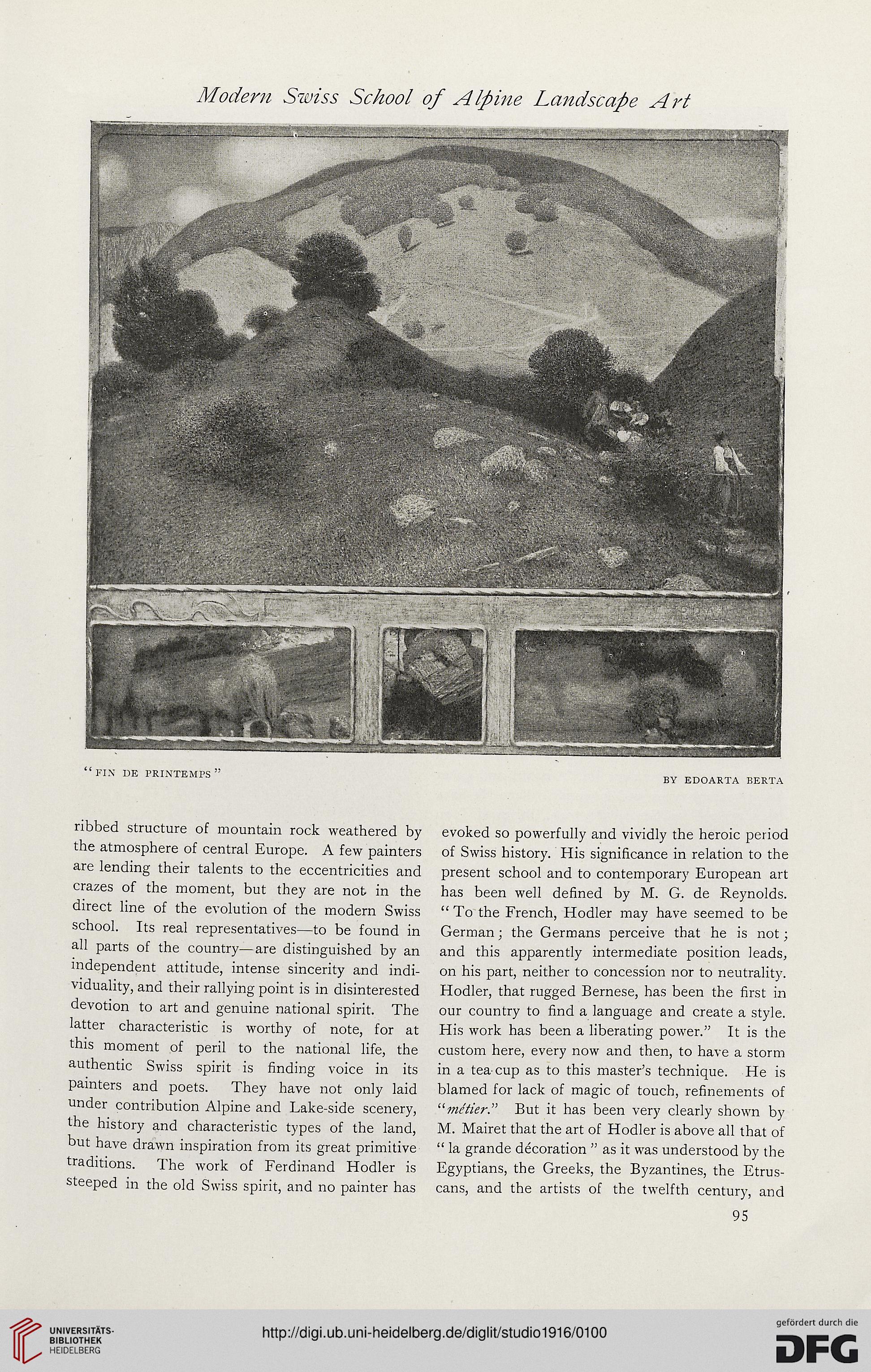Modern Swiss School of Alpine Landscape Art
“fin de printemps
BY EDOARTA BERTA
ribbed structure of mountain rock weathered by
the atmosphere of central Europe. A few painters
are lending their talents to the eccentricities and
crazes of the moment, but they are not in the
direct line of the evolution of the modern Swiss
school. Its real representatives—to be found in
all parts of the country—are distinguished by an
independent attitude, intense sincerity and indi-
viduality, and their rallying point is in disinterested
devotion to art and genuine national spirit. The
latter characteristic is worthy of note, for at
this moment of peril to the national life, the
authentic Swiss spirit is finding voice in its
painters and poets. They have not only laid
under contribution Alpine and Lake-side scenery,
the history and characteristic types of the land,
but have drawn inspiration from its great primitive
traditions. The work of Ferdinand Hodler is
steeped in the old Swiss spirit, and no painter has
evoked so powerfully and vividly the heroic period
of Swiss history. His significance in relation to the
present school and to contemporary European art
has been well defined by M. G. de Reynolds.
“ To the French, Hodler may have seemed to be
German; the Germans perceive that he is not;
and this apparently intermediate position leads,
on his part, neither to concession nor to neutrality.
Hodler, that rugged Bernese, has been the first in
our country to find a language and create a style.
His work has been a liberating power.” It is the
custom here, every now and then, to have a storm
in a tea cup as to this master’s technique. He is
blamed for lack of magic of touch, refinements of
“metier.” But it has been very clearly shown by
M. Mairet that the art of Hodler is above all that of
“ la grande decoration ” as it was understood by the
Egyptians, the Greeks, the Byzantines, the Etrus-
cans, and the artists of the twelfth century, and
95
“fin de printemps
BY EDOARTA BERTA
ribbed structure of mountain rock weathered by
the atmosphere of central Europe. A few painters
are lending their talents to the eccentricities and
crazes of the moment, but they are not in the
direct line of the evolution of the modern Swiss
school. Its real representatives—to be found in
all parts of the country—are distinguished by an
independent attitude, intense sincerity and indi-
viduality, and their rallying point is in disinterested
devotion to art and genuine national spirit. The
latter characteristic is worthy of note, for at
this moment of peril to the national life, the
authentic Swiss spirit is finding voice in its
painters and poets. They have not only laid
under contribution Alpine and Lake-side scenery,
the history and characteristic types of the land,
but have drawn inspiration from its great primitive
traditions. The work of Ferdinand Hodler is
steeped in the old Swiss spirit, and no painter has
evoked so powerfully and vividly the heroic period
of Swiss history. His significance in relation to the
present school and to contemporary European art
has been well defined by M. G. de Reynolds.
“ To the French, Hodler may have seemed to be
German; the Germans perceive that he is not;
and this apparently intermediate position leads,
on his part, neither to concession nor to neutrality.
Hodler, that rugged Bernese, has been the first in
our country to find a language and create a style.
His work has been a liberating power.” It is the
custom here, every now and then, to have a storm
in a tea cup as to this master’s technique. He is
blamed for lack of magic of touch, refinements of
“metier.” But it has been very clearly shown by
M. Mairet that the art of Hodler is above all that of
“ la grande decoration ” as it was understood by the
Egyptians, the Greeks, the Byzantines, the Etrus-
cans, and the artists of the twelfth century, and
95




